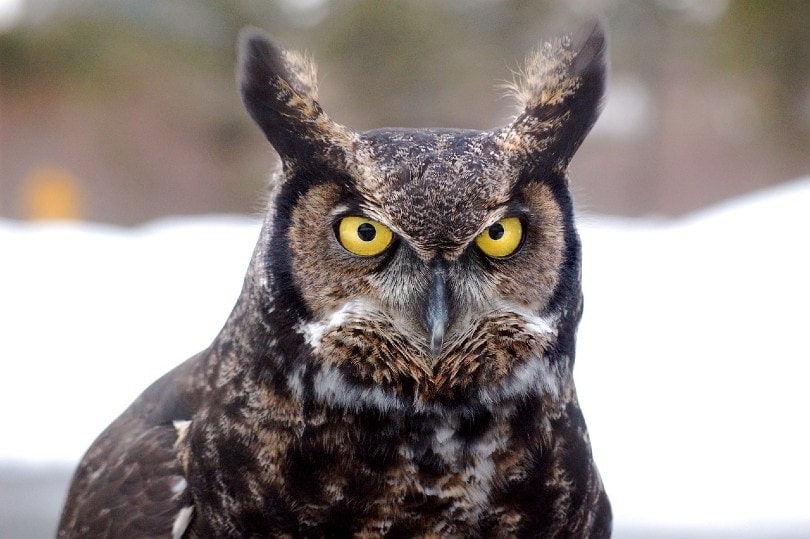Do Owls Eat Other Birds? Hunting Techniques & Most Common Owls
Last Updated on

Owls are birds of prey, which means that they are carnivorous and that they prey on animals for food. Depending on the particular species of owl, their food can include insects like moths, rodents like mice, and even some smaller birds. Some owls, such as the Eagle Owl, will even hunt birds as large as ducks. These birds are very well equipped to take down their quarry and seeing one wrestling with another bird, in flight, truly is a sight. Unfortunately, their nocturnal habits mean that it is rare for us to see them in action.

Owl Hunting Techniques
https://www.instagram.com/p/B5349IWFxr6/
Owls usually have a hunting patch that is away from their nesting site. They have excellent eyesight that allows them to spot their prey, in the dark, from overhead. They have equally good hearing, too, which means that they can hear the rustle of grass and the movement of small animals below them. They also have long, sharp talons, that they can use to grab their prey and silent flight feathers that enable them to surprise even the most alert of animals.
Owls change their hunting techniques according to the type of prey they are chasing, so they will have a different technique when hunting mice on the ground compared to the method they use when trying to take down small birds in the air.

4 Most Common Owl Species
In the US, there are 19 different species of owl, ranging in size from the tiny elf owl to the massive great gray owl. Below are five of the species that you are most likely to see if you are lucky enough to spot them at all.
1. Great Horned Owls

The great horned owl is so named for its tufted ears and this species has a diverse menu. It will eat insects but will also go after mammals as well as other birds. Its size means that the great horned owl will hunt other birds of prey and waterfowl, such as ducks. Because this owl is willing to hunt during the day, in the right conditions, it is one species that you have a reasonable chance of seeing.
2. Short-Eared Owls
https://www.instagram.com/p/CW8vRHKo4hQ/
Another species that you can see during the day is the short-eared owl. Unusually, it hunts during the day when it flies over the water. It is most often seen during the winter months and, as well as mammals, the short-eared owl will prey on small birds. They can be spotted on the ground, as well as on tree-based perches.
3. Long-Eared Owls

The long-eared owl has distinctive facial features and they like open areas, where they hunt at night. They typically only feed on small mammals, however, and are not usually seen chasing birds.
4. Barn Owls

The barn owl is perhaps one of the best-known owl species. While it is a nocturnal bird, its white color means that you might see it flash overhead as it chases mice, rabbits, and other small mammals. They will eat some small birds if they are fortunate enough to find them, and barn owls are known to have some of the best hearing among all animal species. Although numbers are in decline, this species will roost in trees and barns, so if you have either of these around your home, you do have a decent chance of catching a glimpse or two.

Do Owls Eat Other Birds?
Owls are skilled and highly adapted birds of prey and, depending on the exact species, their diet can range from frogs and small mammals to songbirds and even ducks. They use their excellent senses of sight and hearing to identify prey, and their silent flight and sharp talons to hunt.
Featured Image Credit: Wild0ne, Pixabay
About the Author Robert Sparks
Robert’s obsession with all things optical started early in life, when his optician father would bring home prototypes for Robert to play with. Nowadays, Robert is dedicated to helping others find the right optics for their needs. His hobbies include astronomy, astrophysics, and model building. Originally from Newark, NJ, he resides in Santa Fe, New Mexico, where the nighttime skies are filled with glittering stars.
Related Articles:
What Is the Best Binocular Magnification for Hunting? Optical Features Explained
How to Clean a Refractor Telescope: Step-by-Step Guide
How to Clean a Telescope Eyepiece: Step-by-Step Guide
How to Clean a Rifle Scope: 8 Expert Tips
Monocular vs Telescope: Differences Explained (With Pictures)
What Is a Monocular Used For? 8 Common Functions
How to Clean a Telescope Mirror: 8 Expert Tips
Brightfield vs Phase Contrast Microscopy: The Differences Explained
